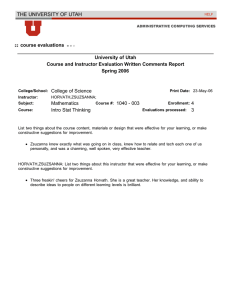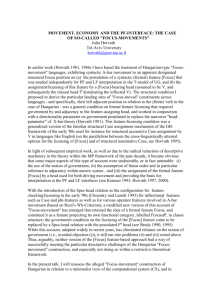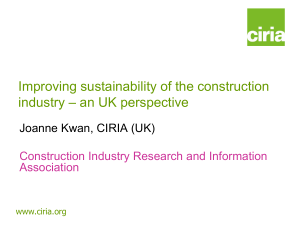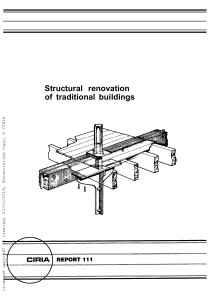Construction for Sustainable Development – A Research and Educational Agenda
advertisement
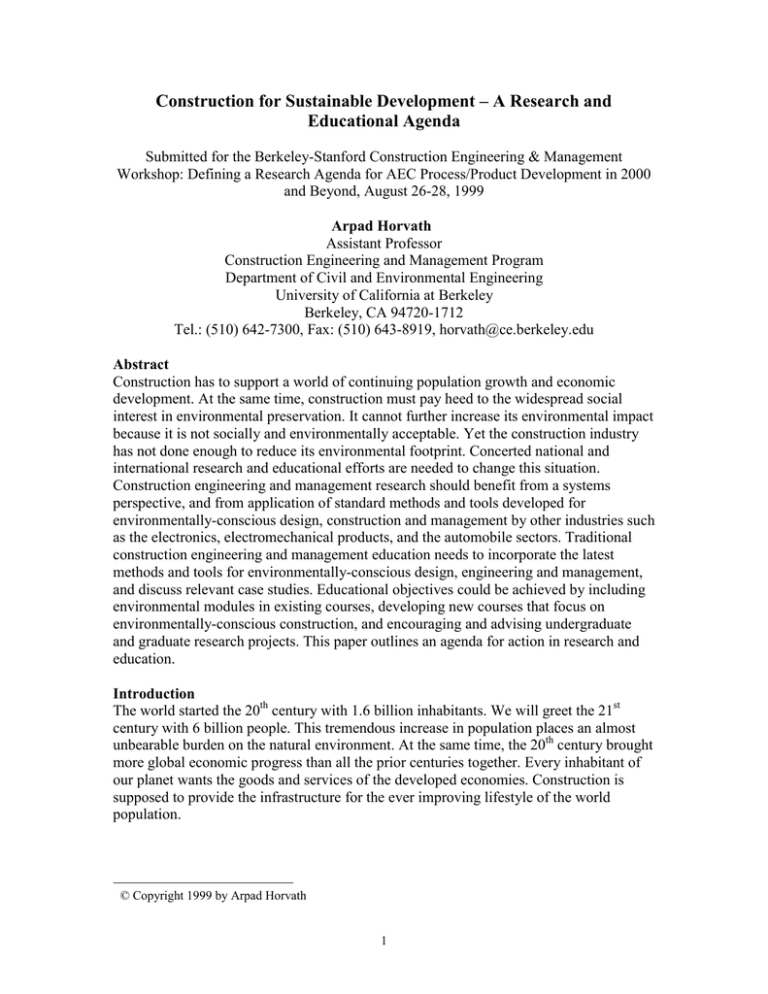
Construction for Sustainable Development – A Research and Educational Agenda Submitted for the Berkeley-Stanford Construction Engineering & Management Workshop: Defining a Research Agenda for AEC Process/Product Development in 2000 and Beyond, August 26-28, 1999 Arpad Horvath1 Assistant Professor Construction Engineering and Management Program Department of Civil and Environmental Engineering University of California at Berkeley Berkeley, CA 94720-1712 Tel.: (510) 642-7300, Fax: (510) 643-8919, horvath@ce.berkeley.edu Abstract Construction has to support a world of continuing population growth and economic development. At the same time, construction must pay heed to the widespread social interest in environmental preservation. It cannot further increase its environmental impact because it is not socially and environmentally acceptable. Yet the construction industry has not done enough to reduce its environmental footprint. Concerted national and international research and educational efforts are needed to change this situation. Construction engineering and management research should benefit from a systems perspective, and from application of standard methods and tools developed for environmentally-conscious design, construction and management by other industries such as the electronics, electromechanical products, and the automobile sectors. Traditional construction engineering and management education needs to incorporate the latest methods and tools for environmentally-conscious design, engineering and management, and discuss relevant case studies. Educational objectives could be achieved by including environmental modules in existing courses, developing new courses that focus on environmentally-conscious construction, and encouraging and advising undergraduate and graduate research projects. This paper outlines an agenda for action in research and education. Introduction The world started the 20th century with 1.6 billion inhabitants. We will greet the 21st century with 6 billion people. This tremendous increase in population places an almost unbearable burden on the natural environment. At the same time, the 20th century brought more global economic progress than all the prior centuries together. Every inhabitant of our planet wants the goods and services of the developed economies. Construction is supposed to provide the infrastructure for the ever improving lifestyle of the world population. 1 © Copyright 1999 by Arpad Horvath 1 While there is much discussion about the ways to achieve progress without lowering environmental quality and quality of life, “sustainable development” is still an elusive goal. The construction industry, as one of the largest and most important industries and at the same time one of the largest polluters, cannot wait until the goals of sustainable development have been identified and tools to achieve them have proved practical. A proactive approach is needed in research and education, precursors for lowering environmental burdens while maintaining sustainable growth. This paper outlines an agenda for research and education. Research Issues Various environmental research topics have been important for the A/E/C industry for decades: energy conservation, indoor air quality, noise, etc. A new set of research issues is emerging, particularly due to the progress of other industrial and service sectors in environmentally-conscious research and practice. Society will increasingly be demanding the same environmental performance from construction as it demands from the chemical, automobile, electrical, electronics industries. The common themes are: Systems perspective. Construction cannot be viewed in isolation from its surroundings, and from its industrial and service base. The supply chain for construction includes practically the entire economy. As construction cannot function without energy, services, etc., the environmental analysis of construction has to include the environmental analysis of the corresponding energy, as well as the other sectors of the economy. The suppliers of construction may have a larger environmental impact than construction itself. Life-cycle perspective. Infrastructure should properly be viewed from a life-cycle perspective. For example, design decisions at the beginning of a project have significant long-term effects. In terms of individual life-cycle stages, operation and maintenance, and end-of-life environmental costs of facilities may outweigh all other costs. Pollution prevention. Environmental remediation is typically more costly than pollution prevention. Civil engineers, architects, construction engineers and managers have a crucial role in determining what the life-cycle environmental loading of the built infrastructure will be. Durability/design life of construction products. Longer life facilities reduce construction process requirements. However, old facilities may become functionally obsolete. Many issues arise: For what period should facilities be designed? How do we predict the rate of obsolescence for our facilities? What is the planning period for the economic analysis of construction products? [Lemer 1996] Active role. A/E/C professionals have an ethical obligation to reduce the environmental impacts of construction, even if the largest impact is realized in the supply chain. A/E/C practitioners and suppliers need to work together to achieve “sustainable” construction practices. 2 The emerging research questions revolve around the main objectives of design for environment and pollution prevention [OTA 1992, Lave 1994]: Construction materials. Beyond the issues of embedded and saved energy, construction materials need to be analyzed through their entire supply chain. Which alternatives have the lowest resource inputs and environmental emissions and wastes throughout their life-cycle? What are the reuse and recycling options, and do they make environmental and economic sense? Construction processes. On-site construction processes have energy, and particulate and chemical emissions implications. Research is needed to quantify and rank these emissions, and establish their impact on the environment and on construction workers. Construction machines. While the environmental authorities are regulating the last ppm of emissions of private cars, construction machines are just now coming under scrutiny in the U.S. Soon construction machines will face similar regulatory requirements as on-road vehicles. What is the magnitude of emissions? What will it cost to reduce it? Construction design. How do we effectively communicate to A/E/C professionals the environmental implications of material selection, design, facility siting, construction method, etc. choices? How do environmental issues get balanced with engineering, economic, quality and safety criteria? How do construction designs get optimized with the triple bottom line (engineering, economics, environment) in mind? Supply-chain management. We need to identify the environmental “weak points” in the construction supply chain, and reduce the burden of the largest polluters costeffectively. What mechanisms do we have to work with suppliers on minimizing their environmental burdens? Operation and maintenance. What are the environmental implications of O&M decisions for particular facilities, and how do we measure them? How do we improve the O&M process to minimize environmental loadings? End-of-life options for constructed facilities. Research is needed to determine the engineering and management options, and economic costs of end-of-life treatment of constructed facilities. Habitat destruction. How do we measure habitat destruction by construction? Esthetic pollution. How do we define and measure it? The research issues are diverse and numerous, yet very important due to the large scale of decisions made in the A/E/C industry. Educational Issues Traditional construction engineering and management education has focused on providing instruction in achieving and maintaining the highest standards in engineering, safety and quality of the built infrastructure at the lowest possible economic costs. Care for environmental concerns has been opportunistic in practice: it has been observed at construction sites if laws or regulations governed them, or if they could be achieved at low cost. 3 Construction engineering and management education needs to incorporate environmental issues into education in a systematic way. The objectives of environmentally-conscious construction education are: to provide every civil engineering student with a notion that environmental issues are increasingly important in construction, in addition to the engineering and economic aspects, and that construction activities have large environmental impacts to teach students in construction engineering and management the practical methods and tools to lower the environmental footprint of construction design and management to organize continuing education courses for construction engineering and management practitioners to inform them about the latest developments in environmentally-conscious construction. These objectives can be achieved by including environmental modules in existing courses developing new courses that focus on environmentally-conscious construction encouraging and advising undergraduate and graduate research projects in environmentally-conscious construction. Incorporation of environmental modules into existing courses: This is a relatively easy way of raising the environmental consciousness of future construction engineers. As most civil engineering students take at least one construction engineering and management course in their curriculum, when a specific topic is discussed in the course, the instructor could devote extra time to including notions of the environmental impacts of construction activities, and the possible mitigation of these impacts. For example, a discussion of formwork design should include the life-cycle costs of utilizing reusable formwork, contrasted to the costs of disposing of formwork at the end of its useful life. A few books [AIA 1997, CIRIA 1994, CIRIA 1995, CIRIA 1995a] a number of journal articles (from ENR, Civil Engineering, etc.; see, e.g., [Bossink 1996]), and a few videos (e.g., about the Three Gorges dam in China, by the Discovery Channel) are particularly useful in these exercises. Objectives of such modules are to provide at least some education about the environmental impacts of construction activities, and encourage environmentally more optimal solutions than the current practice. Such practice is already observed in the introductory civil engineering classes at Carnegie Mellon University. Development of new courses in environmentally-conscious construction: Students who focus on construction engineering and management (as well as other interested civil engineering students) will want in-depth knowledge of the magnitude, type, details and possible solutions to environmental problems in construction. Such a course needs to focus on pollution prevention more than on traditional environmental remediation techniques. The course objectives could be achieved through the introduction of general methods and tools for pollution prevention, design for environment and industrial ecology, as well as through case studies and class projects. The courses Advanced Techniques for Project Management and Management Principles and Practices for Environmental Engineering in the Department of Civil and Environmental Engineering at Carnegie Mellon have used these techniques. The instructors initially had the difficulty of 4 not having enough course material. Parts of various textbooks can be used for instruction on general methods and tools and discussion of case studies [Moavenzadeh 1994, Graedel 1995]. Text on specific construction design and engineering problems also exists (see, e.g., [FHWA-EPA 1993, DOT 1993, Horvath 1998a, Horvath 1998b]). Examples from environmentally more mature industries (such as the electronics and the automobile sectors) may also be used for illustration of basic concepts and systems approaches. Continuing education courses are also desirable given that environmental problems may not have been discussed in the courses that current A/E/C professionals have taken. The aforementioned course materials could be useful for practicing professionals as well. Undergraduate and graduate research projects in environmentally-conscious construction: Students should be encouraged to take on research projects in construction that have an environmental component. For undergraduate students, class projects (individual or group) and independent studies are suitable. For example, students could analyze the waste management practices of a construction site, following it through perhaps a couple of courses. Graduate student research projects and theses should focus on the identification of and solution to a current or emerging construction issue such as end-oflife responsibility of owners for construction products. References [AIA 1997] American Institute of Architects, “Environmental Resource Guide,” New York: John Wiley & Sons, 1997, ISBN 0-471-14043-0. [Bossink 1996] Bossink, B. A. G., and H. J. H. Brouwers, “Construction Waste: Quantification and Source Evaluation,” J. of Construction Engineering and Management, 122(1), pp. 55-60, March 1996. [CIRIA 1994] Venables, R., D. Housego, J. Chapman, J. Newton, P. Castle, A. PeirsonHills, “Environmental Handbook for Building and Civil Engineering Projects - Volume 1: Design and Specification,” Construction Industry Research and Information Association (CIRIA), Special Publication 97, 1994, ISBN 0-86017-377-1. [CIRIA 1995] Guthrie, P, and H. Mallett, “Waste Minimisation and Recycling in Construction - A Review,” Construction Industry Research and Information Association (CIRIA), Special Publication 122, 1995, ISBN 0-86017-428-X. [CIRIA 1995a] Construction Industry Research and Information Association, “Environmnetal Impact of Materials - Volume A: Summary,” CIRIA, Special Publication 116, 1995, ISBN 0-86017-424-7. [DOT 1993] U.S. Department of Transportation, “A Study of the Use of Recycled Paving Material: Report to Congress,” Washington, D.C.: Federal Highway Administration, FHWA-RD-93-147, EPA/600/R-93/095, June 1993. 5 [FHWA-EPA 1993] Bloomquist, D., G. Diamond, M. Oden, B. Ruth, and M. Tia, “Engineering and Environmental Aspects of Recycled Materials for Highway Construction - Final Report,” U.S. Department of Transportation, Federal Highway Administration, and U.S. Environmental Protection Agency, Report No. FHWA-RD-93088, July 1993. [Graedel 1995] Graedel, T. E., and B. R. Allenby, “Industrial Ecology,” Englewood Cliffs, NJ: Prentice Hall, 1995, ISBN 0-13-125238-0. [Horvath 1998 a] Horvath, A. and Hendrickson, C. T., “Steel vs. Steel-Reinforced Concrete Bridges: Environmental Assessment.” J. of Infrastructure Systems, ASCE, September 1998, pp. 111-117. [Horvath 1998b] Horvath, A., and Hendrickson, C. T., “A Comparison of the Environmental Implications of Asphalt and Steel-Reinforced Concrete Pavements.” Transportation Research Record, NRC, No. 1626 (Environmental and Social Effects of Transportation), pp. 105-113, 1998. [Lave 1994] Lave, L. B., F. C. McMichael, and C. Hendrickson, “Recycling Decisions and Green Design,” Environmental Science & Technology, 28(1), pp. 18A-24A, 1994. [Lemer 1996] Lemer, A. C., “Infrastructure Obsolescence and Design Service Life,” Journal of Infrastructure Systems, 2(4), pp. 153-161, December 1996. [Moavenzadeh 1994] Moavenzadeh, F., “Global Construction and the Environment,” John Wiley & Sons, 1994, ISBN 0-471-01289-0. [OTA 1992] Office of Technology Assessment, “Green Products by Design: Choices for a Cleaner Environment,” OTA-E-541, Washington, DC: U.S. Government Printing Office, October 1992. Background of the Author Arpad Horvath joined the Construction Engineering and Management Program at University of California at Berkeley in July 1999. Prior to his appointment there, he was Research Engineer in Civil and Environmental Engineering at Carnegie Mellon University (1997-99). He holds PhD and Master of Science degrees in Civil Engineering from Carnegie Mellon, and a 5-year degree (Dipl. Ing.) in Civil Engineering from the Technical University of Budapest in Hungary. Arpad Horvath’s interest in civil engineering and environmental systems stems from his work in the Green Design Initiative, an interdisciplinary research institute in environmentally-conscious design, engineering and manufacturing at Carnegie Mellon which he joined in 1993. He has performed research on environmental performance measurement, life-cycle assessment, product takeback systems, and environmentallyconscious design, material selection, and management in construction. His latest research concerns the supply-chain environmental implications of the service industries. He is the 6 author of numerous journal and conference articles, and the recipient of the 1998-99 NSF-Lucent Technologies Industrial Ecology Fellowship, and the 1998-99 AT&T Industrial Ecology Faculty Fellowship. He is one of the creators of the first fully functional life-cycle assessment software on the World Wide Web (www.eiolca.net). 7
